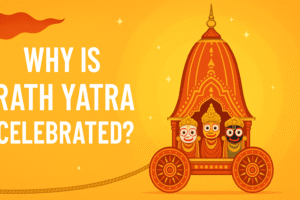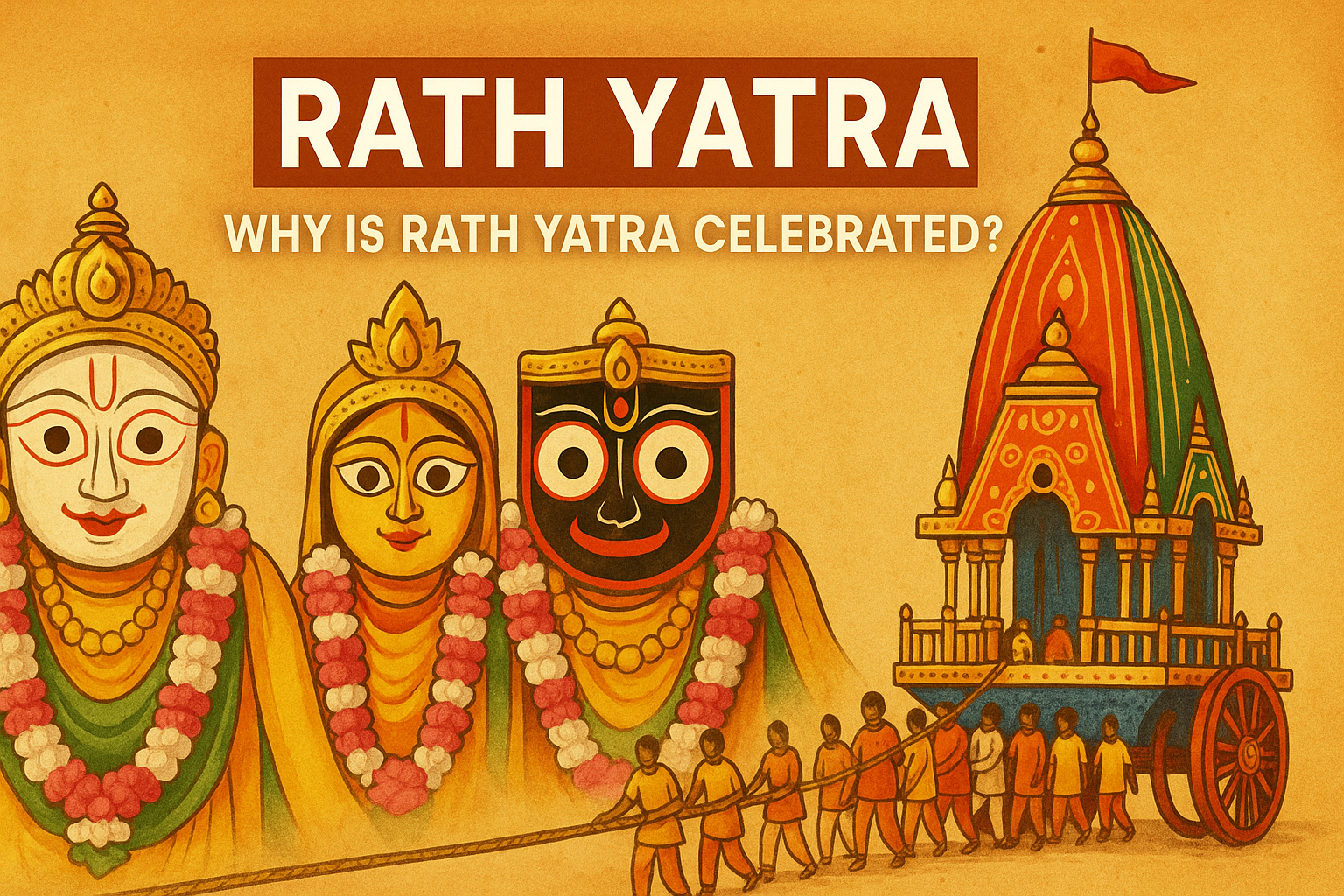
Why is Rath Yatra Celebrated?
Unveiling the Sacred Journey of Lord Jagannath
Every year, millions of devotees gather in Puri, Odisha, with hearts brimming with devotion and chants of “Jai Jagannath!” echoing in the air. The occasion? The grand and sacred Rath Yatra, or the Chariot Festival—one of the most significant and ancient festivals in Hinduism. But have you ever wondered why this divine procession is celebrated with such passion and scale?
Let’s explore the spiritual, mythological, and cultural significance behind Rath Yatra.
🌟 The Divine Trio: Jagannath, Balabhadra & Subhadra
Rath Yatra centers around Lord Jagannath, a form of Lord Krishna, along with his elder brother Balabhadra and sister Devi Subhadra. These three deities reside in the world-famous Jagannath Temple in Puri.
Unlike other Hindu deities, these idols are made of wood and are ceremoniously replaced every 12 to 19 years in a ritual known as Nabakalebara. But once every year, during the Ashadha month (June-July), something extraordinary happens.
🚩 The Journey to Their Aunt’s House
According to legends, once Lord Krishna expressed a desire to visit Gundicha Temple, his maternal aunt’s place, situated about 3 km from the Jagannath Temple. This symbolic journey is what we celebrate today as Rath Yatra.
The three siblings travel in grand wooden chariots (Raths), pulled by thousands of devotees with immense devotion and enthusiasm. The event symbolizes the Lord coming out to bless the common people, transcending barriers of caste, creed, and status.
Table of Contents
📜 Mythological Significance
There are multiple layers of spiritual meaning behind the Rath Yatra:
Krishna’s Vrindavan Journey: Many associate it with Lord Krishna’s journey from Dwarka to Vrindavan, symbolizing his eternal bond with the devotees of Vrindavan.
Detachment and Dharma: The temporary removal of the deities from the temple reminds devotees of the impermanence of life and the importance of Dharma.
Unity of Siblings: The presence of all three siblings in the Yatra reflects family unity, love, and divine harmony.

Why is Rath Yatra Celebrated?
🌈 A Festival of Faith and Unity
Rath Yatra isn’t just a festival—it’s an emotion.
People from all over the world—irrespective of religion—participate in this celebration.
Devotees believe that pulling the ropes of the chariot cleanses their sins and grants blessings.
Even touching the chariot or being in its presence is considered highly auspicious.
The sheer energy, the sea of saffron flags, the rhythmic drums, and the tear-filled eyes of devotees create a spiritual atmosphere like no other.
🌍 Celebrations Beyond Puri
While Puri hosts the most iconic Rath Yatra, the festival is also celebrated in places like:
Ahmedabad, Gujarat – the second-largest Rath Yatra in India.
ISKCON temples worldwide, especially in the US, UK, and Australia.
Kolkata, Delhi, and other Indian cities with Jagannath temples.
✨ The Essence of Rath Yatra
Rath Yatra teaches us that God comes to the doorsteps of devotees, not the other way around. It’s a reminder that divinity is accessible to all, regardless of social or economic background.
It is a journey of love, humility, and surrender.
🙏 Final Thoughts
Rath Yatra is not just a ritual—it’s a moving story of devotion, divine play, and human connection with God. Whether you’re watching it live in Puri or catching a glimpse online, the experience is bound to leave a lasting imprint on your heart.
So this Ashadha, join the divine procession, chant the holy names, and let your soul ride the chariot of devotion.
Jai Jagannath! 🙌🚩
🙋♂️ FAQs on Rath Yatra
- What is the meaning of Rath Yatra?
Rath Yatra literally means “Chariot Journey.” It refers to the annual ceremonial procession where the deities—Lord Jagannath, Balabhadra, and Subhadra—are taken out of their temple in huge chariots to visit the Gundicha Temple.
- Why is Rath Yatra celebrated every year?
Rath Yatra is celebrated to commemorate Lord Jagannath’s visit to his aunt’s temple (Gundicha Temple), symbolizing his love for devotees. It also reflects the divine act of God stepping out of the temple to bless everyone, especially those who cannot enter the temple.
- When is Rath Yatra celebrated in 2025?
In 2025, Rath Yatra will be celebrated on June 29th (Ashadha Shukla Dwitiya), based on the Hindu lunar calendar.
- Where is the biggest Rath Yatra held?
The largest and most famous Rath Yatra takes place in Puri, Odisha, at the Jagannath Temple. It attracts millions of pilgrims and tourists from around the world.
- What is the significance of the three chariots?
Each deity has a separate chariot:
- Nandighosha for Lord Jagannath (16 wheels)
- Taladhwaja for Lord Balabhadra (14 wheels)
- Darpadalana for Devi Subhadra (12 wheels)
These chariots are constructed new every year and symbolize divine vehicles carrying the Lord to his devotees.
6. What happens during the 9-day Rath Yatra?
- Day 1: The deities are pulled to Gundicha Temple.
- Days 2–8: They rest and are worshipped at Gundicha.
- Day 9: Bahuda Yatra, or the return journey, brings them back to the main temple.
7. Can anyone pull the chariots?
Yes. One of the most unique aspects of Rath Yatra is that anyone, regardless of caste, gender, or religion, can pull the chariots. It symbolizes equality before God.
- Why are the deities made of wood?
Unlike most Hindu idols, the deities of the Jagannath temple are made of Neem wood, signifying impermanence and the cycle of rebirth. They are replaced every 12 to 19 years in a special ceremony called Nabakalebara.
- Is Rath Yatra celebrated outside Puri?
Yes, Rath Yatra is also celebrated in:
- Ahmedabad (Gujarat)
- Kolkata, Delhi, Mumbai, and other Indian cities
- Internationally in ISKCON temples across the USA, UK, Australia, and more
10. What is the spiritual message of Rath Yatra?
The festival teaches humility, devotion, and the idea that God reaches out to devotees. It emphasizes that spiritual grace is for everyone, not just temple-goers.
🛕 Summary: Why is Rath Yatra Celebrated?
Rath Yatra, also known as the Chariot Festival, is an ancient Hindu celebration held every year in Puri, Odisha, where the deities Lord Jagannath, Balabhadra, and Subhadra are taken out of their temple and placed on grand wooden chariots to visit the Gundicha Temple—their maternal aunt’s home.
This sacred journey symbolizes God’s love for his devotees, breaking traditional temple boundaries to bless people of all backgrounds. Spiritually, it reflects divine humility, the unity of siblings, and the importance of detachment from worldly attachments.
Celebrated with immense devotion and colorful processions, Rath Yatra brings together millions of people from all over the world, emphasizing faith, equality, and spiritual unity. The festival is not just a ritual—it is a powerful spiritual movement that connects every heart to Lord Jagannath.
Jai Jagannath! 🙏🚩
Unlock the Ancient Wisdom of Sanatan Dharma – Join Us on YouTube!
👉 Subscribe now to Prachin Sanatan Dharma and embark on a journey of enlightenment.
Explore timeless teachings, spiritual insights, and cultural richness on our YouTube channel, Prachin Sanatan Dharma. Dive deep into the essence of Sanatan Dharma through captivating videos that inspire and educate.
Related Articles
- Restful Nights: Ayurvedic Remedies and Traditional Indian Practices to Overcome Insomnia and Late-Night Habits
- The Tridevi: Lakshmi, Saraswati, and Parvati – Their Roles and Powers
- “Divine Creatures of Ancient Indian Scriptures: Exploring the Role of Animals in the Vedas, Puranas, and Mahabharata”
- Nature and Spirituality: Exploring the Sacred Essence of the Himalayas, Ganga, and Other Natural Wonders”
- “Reviving the Gurukul System: Relevance and Lessons for Modern Education”
- “Exploring Greek and Indian Mythology: Similarities Between Greek and Indian Mythology “
- “Embracing Sattvic Living: Harmonizing Mind, Body, and Soul Through Food and Lifestyle”
- “Charity and Prosperity: Exploring the Concept of Daan and Its Financial Relevance in Modern Life”
- How to Build an Eco-Friendly Home Inspired by Vastu Shastra
- Comparison of Ancient and Modern Sports: How Traditional Sports Have Influenced Contemporary Games
- “Timeless Lessons from Ancient Tales: Linking Samudra Manthan and Ganga’s Descent to Modern Ecological Challenges”
- “Reviving Sanskrit: How AI is Preserving Ancient Languages for the Future”
- “Mathura: The Sacred Land of Lord Krishna’s Divine Leelas”
- Investing for Future Generations: Lessons from Indian Traditions on Legacy Building and Wealth Preservation
- “Ancient Indian Wisdom: Timeless Lessons for Tackling Today’s Climate Crisis”
- “Artificial Intelligence and Spirituality: Transforming Ancient Practices for the Modern World”
- “Gold and Real Estate in India: Timeless Assets Shaping Financial Strategies”
- Tradition Meets Innovation: The Evolution of Technology in Hindu Rituals
- End-of-World Myths: Exploring Kali Yuga in Hinduism and Ragnarök in Norse Mythology
- Garuda, Pegasus, and Dragons: The Universal Ties of Mythical Beasts Across Cultures
- “Ancient Vimanas: Mythical Flying Machines or Evidence of Advanced Technology?”
- Time Travel in Hindu Mythology: The Fascinating Tales of Kakudmi and King Raivata
- “Divine Feminine Power in Hindu Mythology: The Legends of Durga, Saraswati, and Lakshmi”
- “Divine Beings of Sanatan Dharma: The Spiritual Significance of Sacred Animals in Hinduism”
- “Symbolism in Mythological Art: Unlocking Hidden Meanings in Ancient Temple Carvings”
- “Exploring Technological Advancements in Ancient India and Civilizations: Vimana, Metallurgy, & Water Management systems”
- Unveiling the Mysteries: Ancient Temples of Sanatan Dharma , Mysterious Temples of India
- “The Scientific Knowledge of Sanatan Dharma: Ancient Wisdom Meets Modern Science”
- Ancient Indian Sports and Games: Celebrating a Legacy of Skill, Strength & Strategy”
- “Exploring the Cosmic Link: The Connection Between Astronomy and Vedic Astrology”
- The Power of Sanskrit: Unlocking the Divine Language of the Gods
- “The End of Kaliyuga: A Sanatan Insight into the World’s Final Chapter”
- Explore more articles on Prachin Sanatan Yuga.
Why is Rath Yatra Celebrated? Why is Rath Yatra Celebrated? Why is Rath Yatra Celebrated? Why is Rath Yatra Celebrated? Why is Rath Yatra Celebrated? Why is Rath Yatra Celebrated? Why is Rath Yatra Celebrated? Why is Rath Yatra Celebrated? Why is Rath Yatra Celebrated? Why is Rath Yatra Celebrated?
Why is Rath Yatra Celebrated? Why is Rath Yatra Celebrated? Why is Rath Yatra Celebrated? Why is Rath Yatra Celebrated? Why is Rath Yatra Celebrated? Why is Rath Yatra Celebrated? Why is Rath Yatra Celebrated? Why is Rath Yatra Celebrated? Why is Rath Yatra Celebrated? Why is Rath Yatra Celebrated?
